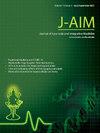解开AYUSH提供者对居住在印度普杜切里城市地区的人们的医疗保健选择的观点-一项并行混合方法研究
IF 1.9
Q3 INTEGRATIVE & COMPLEMENTARY MEDICINE
引用次数: 0
摘要
替代医学的日益流行使AYUSH(阿育吠陀、瑜伽和自然疗法、乌纳尼、悉达和顺势疗法)系统成为向中低收入国家提供负担得起的、文化上合适的医疗保健的宝贵工具。然而,克服扩大这些传统系统的挑战是获得更广泛接受这种有前途的医疗保健方法的关键。目的了解AYUSH使用率及相关因素。并且,探讨AYUSH提供者对支持或阻碍采用AYUSH及其与传统医学结合的因素的看法。材料与方法于2023年9月至12月采用并行混合方法研究。采用预先测试的问卷,通过上门调查来评估AYUSH的使用率。在AYUSH从业人员中进行了10个关键信息提供者访谈,并使用主题分析进行了分析。结果使用率为19.2% (95% CI:16.9% ~ 21.6%)。观察到合并症患者之间存在显著关联(aPR: 1.5; 95% CI: 1.0-2.1; p值<;0.05)。定性分析显示,日益增长的公众兴趣和政府支持是关键的推动因素,而有限的科学验证和劳动力短缺是主要障碍。从卫生系统的角度来看,AYUSH提供者谈到了政策和治理改革的必要性,以创建一个更加统一的卫生保健系统。结论尽管存在一些挑战,但研究结果表明,AYUSH因其自然方法而越来越受到青睐。越来越多的人接受综合医学,这突出了对有凝聚力的护理模式和改善可及性的需要。该研究强调了解决各州具体需求和标准化AYUSH实践以促进一体化的重要性。本文章由计算机程序翻译,如有差异,请以英文原文为准。
Unravelling AYUSH providers’ perspectives on healthcare choices of people residing in urban areas of Puducherry, India- A concurrent mixed method study
Background
The rising popularity of alternative medicine positions AYUSH (Ayurveda, Yoga & Naturopathy, Unani, Siddha, and Homoeopathy) systems as valuable tools for providing affordable, culturally appropriate healthcare to low-middle-income countries. However, overcoming the challenges of scaling up these traditional systems is key to gaining broader acceptance of this promising healthcare approach.
Objectives
To determine the prevalence and associated factors of AYUSH utilization. And, to explore the perceptions of AYUSH providers on factors supporting or hindering AYUSH adoption, and its integration with conventional medicine.
Material and methods
A concurrent mixed-method study was employed between September and December 2023. Prevalence of AYUSH utilization was assessed via door-to-door survey using pre-tested questionnaire. Ten key informant interviews were conducted among AYUSH practitioners and analyzed using thematic analysis.
Results
Prevalence of AYUSH utilization was 19.2% (95% CI:16.9% – 21.6%). A significant association among people with comorbidities (aPR: 1.5; 95% CI: 1.0–2.1; P-value<0.05) is observed. Qualitative analysis revealed that growing public interest and government support were key enablers, while limited scientific validation and workforce shortage were major barriers. From the health systems perspective, AYUSH providers spoke about the need for policy and governance reforms to create a more unified healthcare system.
Conclusion
Despite some challenges, the findings suggest that AYUSH is increasingly favoured for its natural approach. A growing acceptance of integrative medicine highlights the need for cohesive care models and improved accessibility. The study emphasizes the importance of addressing state-specific needs and standardizing AYUSH practices to facilitate integration.
求助全文
通过发布文献求助,成功后即可免费获取论文全文。
去求助
来源期刊

Journal of Ayurveda and Integrative Medicine
INTEGRATIVE & COMPLEMENTARY MEDICINE-
CiteScore
4.70
自引率
12.50%
发文量
136
审稿时长
30 weeks
 求助内容:
求助内容: 应助结果提醒方式:
应助结果提醒方式:


